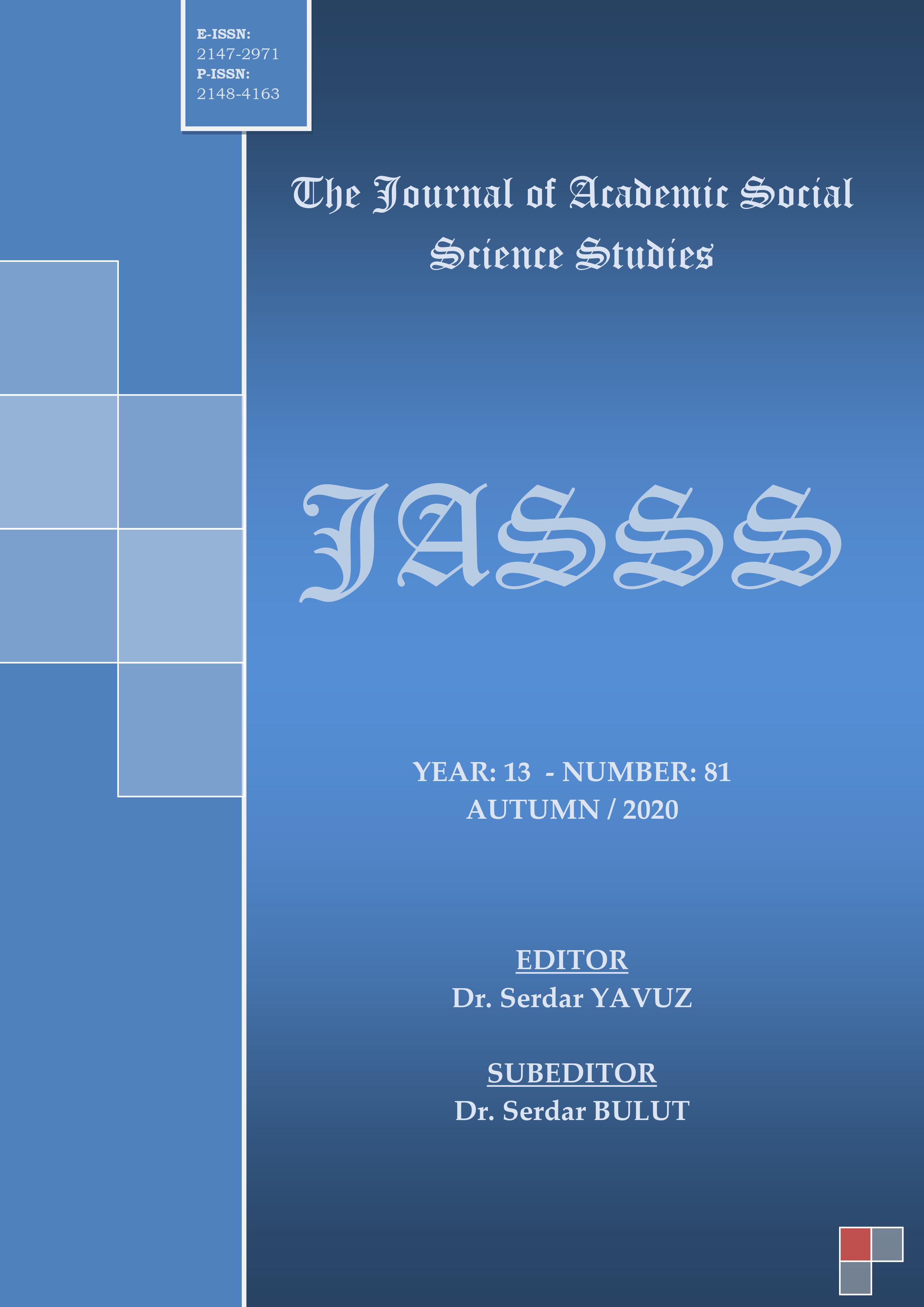“WHERE ANGELS FEAR TO TREAD”: LEVINAS’IN ETİK İLGİSELLİK VE LAYDER’IN ÖNLENEMEYEN ARZU BAKIŞ AÇISIYLA
Author :
Abstract
Meleklerin Uğramadığı Yer (1905) adıyla E. M. Forster tarafından yazılan ilk roman iki farklı kültür ve toplum arasında geçer. Forster bilinçli bir biçimde insanoğlunun tinselliği üzerinde tanınmayan yerlerin ve değerlerin etkisini ortaya koyabilmek adına hem Sawston, İngiltere’den hem de Monteriano, Italya’dan ele aldığı karakterleri birbirleriyle karşılaştırır. Dolayısıyla, bu çalışmanın amacı romandaki hem kadın hem de erkek karakterlerin Edward dönemi toplumunun yerleşmiş kültürel normlar ve sosyal kodlarını Emanuel Levinas’ın “etik ilgisellik” ve Derek Layder’ın “önlenemeyen arzu”, ve bunların yanı sıra, diğer kuramcıların bakış açılarıyla incelemektir. Bu çalışmada bir taraftan Levinas’ın “etik ilgisellik” ile birlikte “duyarlılık”, “öznellik” ve “yakınlık” gibi kavramları irdelenirken diğer taraftan Layder’in “önlenemeyen arzu” kavramını da mimetik kurama uygun olarak incelenmektedir. Levinas açısından, ötekiliğe öznellik bütün karakterlerin aynı romanda olduğu gibi kendi etik ilgisellikleri aracılığıyla diğerleriyle etkileşim kurması anlamına gelir. Levinas’ın bakış açısına göre, Forster çoğunlukla benliğin önyansıtma yerini göz önünde bulundurarak karakterleri arasındaki yakınlık kavramını, daha çok tinsel ve duygusal yakınlık kavramları olarak ele alır. Bunu yapabilmek için Forster farklı ülkeler, milletler ve sınıfları ele alır. Levinas’tan farklı olarak bu çalışma aynı zamanda Layder’in bakış açısıyla karakterlerin içsel zihinsel yaşamları ve rasyonel düşünceleri içinde yer alan “önlenemeyen arzu” kavramındaki gizemi ortaya çıkarır.
Keywords
Abstract
The first novel written by E. M. Forster entitled Where Angels Fear to Tread (1905) revolves around two distinctive cultures and societies. Forster deliberately juxtaposes the characters both from Sawston, England, and Monteriano, Italy to expose the effect of unfamiliar settings and values on the spirituality of the human being. Accordingly, the aim of this study is to examine the perceptions and manner of female and male characters to the established cultural norms and societal codes of the Edwardian society through the lenses of Emanuel Levinas’s “ethical relatedness” and Derek Layder’s “uncontrollable desire” besides the perspectives of many other scholars. This study attempts, on the one hand, to explore Levinasian “ethical relatedness” with its concepts such as “sensibility”, “subjectivity” and “proximity”, on the other, discovers Layderian “uncontrollable desire” in conformity with mimetic theory. In Levinasian terms, subjectivity to otherness indicates that all the characters interact with the other by means of their own ethical relatedness as is the case in the novel. In regard to Levinas’s notion, Forster also provides proximity among his characters mostly, spiritual and emotional proximity by considering the prereflective locus of the self. In order to do this, Forster employs distant countries, nations and classes. Apart from Levinas, this study also unveils the secrecy of “uncontrollable desire” in the inner mental life and rational thought of the characters through the Layderian perspective. The study concludes that both male and female characters, somewhat, behave inconformity with their own ethical relatedness and try to control their “uncontrollable desire”.
Keywords
- Arnold, M. (1970). Culture and Anarchy. (Ed.). J. Dover Wilson, Cambridge: Cambridge University Press [1869].
- Barnard, C. P., & Corrales, R. G. (1979). The Theory and Technique of Family Therapy. Charles C. Thomas Pub Ltd.
- Butler, J. P. (2005). Giving An Account of Oneself. New York: Fordham University Press.
- Drabinski, J. (2001). Sensibility and Singularity: The Problem of Phenomenology in Levinas. Albany: SUNY Press.
- Edwards, M. (2002). E. M. Forster: The Novels. London: Palgrave.
- Eliot, T. S. (1948). Notes towards the Definition of Culture. London: Faber & Faber.
- Forster, E. M. (1993). Where Angels Fear to Tread (1st pub. 1905 by William Blackwood & Sons, Edinburgh, London). USA: Dover Thrift Editions.
- Gallagher, S. (2007). Simulation Trouble. Social Neuroscience, 2(3/4), 353–365.
- Goodlad, L. M. E. (2006). Where Liberals Fear to Tread: E. M. Forster’s Queer Internationalism and the Ethics of Care. A Forum on Fiction, 39(3), 307-336.
- Gordon, J. B. (1985). The Third Cheer: “Voice” in Forster. Twentieth Century Literature, 31(2/3), 315-328.
- Hall, J. (1958). Forster’s Family Reunions. EHL, 25(1), 60-78.
- Krueger, J. W. (2008). Levinasian Reflections on Somaticity and the Ethical Self. Inquiry, 51(6), 603-626.
- Layder, D. (1997). Modern Social Theory: Key Debates and New Directions. London: University College London Press.
- Layder, D. (2004). Social and Personal Identity: Understanding your Self. London: Sage.
- LeDoux, J. (2015). Anxious: Using the Brain to Understand and Treat Fear and Anxiety. New York: Penguin.
- Levinas, E. (1998). Discovering Existence with Husserl, (Trans.). R. Cohen & M. Smith. Evanston: Northwestern University Press.
- Sara, A. (2010). Happy Objects. in Greg, M. & and G. Seigworth (Eds.). The Affect Theory Reader. (29-51). Durham: Duke UP.
- Schwarz, D. R. (1983). The Originality of E. M. Forster. Modern Fiction Studies, 29(4), 623-641.
- Sehgal, R. P. (1973). The function of multi-national characters, alien settings and diverse mores in E. M. Forster’s three international novels: “Where Angels Fear to Tread” (1905), “A Room with a View”, (1908), and “A Passage to India”, (1924). Unpublished Doctoral Dissertation, University of Ottawa, Canada.
- Simon, R. K. (1985). E. M. Forster’s Critique of Laughter and the Comic: The First Three Novels as Dialectic. Twentieth Century Literature, 31(2/3), 199-220.
- Sugate, A. S. (2012). The Novels of E. M. Forster: A thematic Study. Unpublished Doctoral Dissertation.
- Toates F. (2014). How Sexual Desire Works: The Enigmatic Urge. Cambridge: Cambridge UP.
- Watson, G. (2003). Forever Forster: Edward Morgan Forster (1879-1970). The Hudson Review, 55(4), 626- 632.
- Wilde, A. (1961). The Aesthetic View of Life: Where Angels Fear to Tread. Modern Fiction Studies, 7, 207- 216.
- Williams, F. (2005). E. M. Forster’s Alexandrian Quartet. Hermathena, (179), 165-193.
- Williams, R. (1965). The Long Revolution. Harmondsworth: Penguin.
- Womack, K. (2000). A Passage to Italy: Narrating the Family in Crisis in E. M. Forster’s “Where Angels Fear to Tread”. Mosaic: A Journal for the Interdisciplinary Study of Literature, 129-144.
